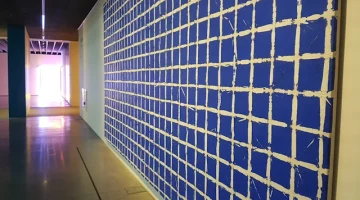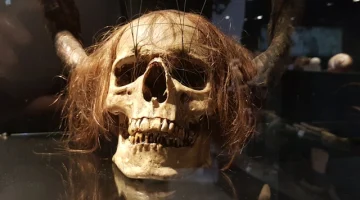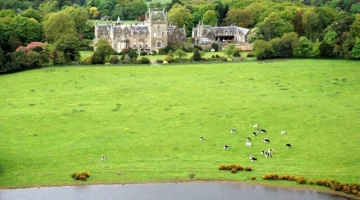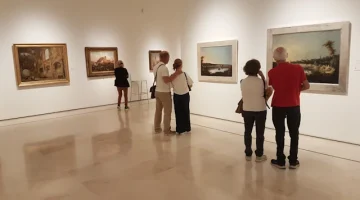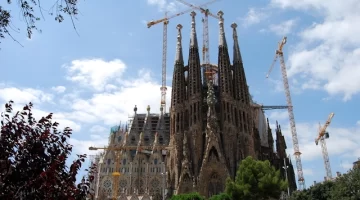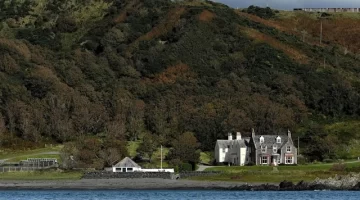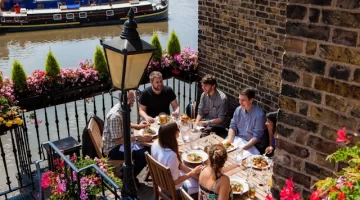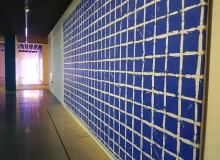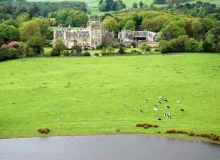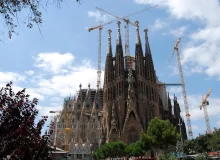The Five Best Cathedrals in Spain
The Travel Pages guide to the five best cathedrals in Spain, from Seville and Santiago de Compostela to the more modern Sagrada Familia in Barcelona.

Spain, a land steeped in history, passion, and artistic grandeur, boasts an architectural heritage unlike any other. Among its most breathtaking treasures are its cathedrals – colossal testaments to faith, engineering prowess, and the enduring spirit of various epochs.
From ancient Roman foundations to soaring Gothic spires and opulent Baroque embellishments, these sacred spaces offer a journey through centuries of art, culture, and devotion. Join us as we embark on a divine tour, exploring five of Spain’s most magnificent cathedrals, each a marvel in its own right.
The Five Best Cathedrals in Spain
-
The Cathedral of Santiago de Compostela: The Pilgrim’s Zenith

History: The final destination for pilgrims walking the Camino de Santiago, the Cathedral of Santiago de Compostela is more than just a church; it’s a spiritual beacon. Legend has it that the remains of Saint James the Greater, one of Jesus’ apostles, were discovered here in the 9th century. This led to the rapid development of Santiago de Compostela as a major pilgrimage site.
The current cathedral, primarily Romanesque in style, began construction in 1075 under the reign of Alfonso VI and was consecrated in 1211. Over the centuries, it has undergone numerous additions and alterations, including significant Baroque and Neo-classical facades, most notably the majestic Obradoiro facade.
Must-See Things:
- The Pórtico da Gloria: This 12th-century Romanesque masterpiece by Master Mateo is a breathtaking sculptural ensemble. depicting scenes from the Apocalypse and Salvation. Look for the “Santo dos Croques” (Saint of the Head Bumps) – a small figure believed to grant wisdom if you touch foreheads with it.
- The Main Altar and Tomb of St. James: The opulent Baroque main altar houses a silver-encased effigy of St. James. Below the altar, accessible via a stairway, is the crypt where the purported relics of St. James are interred.
- Botafumeiro: Witnessing the swinging of the Botafumeiro, one of the world’s largest thuribles, is an unforgettable experience, particularly during solemn masses. Its dramatic arc and the scent of incense fill the vast nave.
- Museo Catedralicio: Explore the cathedral museum for a deeper dive into its history, art, and liturgical treasures, including tapestries, chalices, and historical documents.
Address: Praza do Obradoiro, s/n, 15704 Santiago de Compostela, A Coruña, Spain
Website: https://www.catedraldesantiago.es/
-
Seville Cathedral: A Testament to Grandeur and Conquest

History: The Cathedral of Saint Mary of the See in Seville, commonly known as Seville Cathedral, holds the distinction of being the largest Gothic cathedral in the world and the third-largest church overall. Its history is deeply intertwined with the Reconquista. Built on the site of the former Almohad Great Mosque, construction began in 1401, a few decades after the Christian reconquest of Seville.
The Chapter decided to “build a church so beautiful and so magnificent that those who see it will think we were mad.” They certainly succeeded. The cathedral incorporated elements of the former mosque, most notably its minaret, which was converted into the iconic Giralda bell tower.
Must-See Things:
- The Giralda: Climb this stunning bell tower for panoramic views of Seville. Originally the minaret of the mosque, it’s a magnificent example of Almohad architecture, later crowned with Renaissance additions. Its ramps, rather than stairs, were designed for horse-mounted muezzins.
- Tomb of Christopher Columbus: A grand monument in the south transept is believed to hold the remains of the famed explorer Christopher Columbus, carried by four allegorical figures representing the kingdoms of Castile, León, Aragon, and Navarre.
- Capilla Mayor (Main Chapel) and Retablo Mayor: The colossal main altarpiece is the largest in the world, a breathtaking golden spectacle depicting scenes from the life of Christ and the Virgin Mary. It took almost a century to complete.
- Patio de los Naranjos: This tranquil orange tree courtyard was once the ablution court of the mosque, offering a peaceful respite from the cathedral’s grandeur.
Address: Av. de la Constitución, s/n, 41004 Sevilla, Spain
Website: https://www.catedraldesevilla.es/
-
Burgos Cathedral: A UNESCO Gothic Masterpiece

History: Declared a UNESCO World Heritage site in 1984, Burgos Cathedral is a prime example of Spanish Gothic architecture, showcasing centuries of evolving artistic styles. Its construction began in 1221, mirroring the French Gothic cathedrals of Bourges and Reims, and continued intermittently for over 300 years.
The result is a harmonious blend of 13th to 16th-century Gothic, with later Renaissance and Baroque additions that enrich its already complex design. It’s particularly renowned for its exceptional verticality and its elaborate decorative elements.
Must-See Things:
- The Facade of Santa María: The main facade is a breathtaking display of Gothic sculpture, with its two towering spires adorned with intricate tracery.
- Capilla del Condestable (Constable’s Chapel): This octagonal chapel from the 15th century is a flamboyant Gothic masterpiece within the cathedral, housing the tombs of the Constable of Castile, Don Pedro Fernández de Velasco, and his wife. Its star-vaulted ceiling is truly remarkable.
- The Escalera Dorada (Golden Staircase): Designed by Diego de Siloé in the 16th century, this grand Renaissance staircase with its gilded balustrade is an artistic marvel, connecting the cathedral to the upper street level.
- Tomb of El Cid and Doña Jimena: In the main crossing, beneath a simple slab, lie the remains of Spain’s legendary national hero, Rodrigo Díaz de Vivar, El Cid Campeador, and his wife.
- Papamoscas (Flycatcher Clock): A curious 18th-century automaton figure that opens its mouth as it strikes the hour, located high up near the nave.
Address: Plaza de Santa María, s/n, 09003 Burgos, Spain
Website: https://www.catedraldeburgos.es/
-
Toledo Cathedral: Primate Church of Spain

History: Officially the Primate Cathedral of Saint Mary of Toledo, this magnificent structure stands as one of the greatest examples of High Gothic architecture in Spain. Built between 1226 and 1493 on the site of a former Visigothic church and later a mosque, its architecture is heavily influenced by French Gothic, particularly Bourges Cathedral.
However, it also incorporates unique Mudejar (Muslim) elements, a testament to Toledo’s rich multicultural history. Its sheer size and the wealth of art contained within reflect Toledo’s historical status as the spiritual heart of Spain.
Must-See Things:
- The Transparente: A spectacular Baroque altarpiece-meets-skylight carved by Narciso Tomé and his sons. This incredible work of art seemingly “opens up” the ceiling behind the main altar, creating a dramatic interplay of light and sculpture, bathed in natural light from a hidden oculus.
- Capilla Mayor (Main Chapel) and Retablo Mayor: The huge main altarpiece is a colossal, multi-story gilded polyptych depicting scenes from the life of Christ, a masterpiece of late Gothic and early Renaissance art.
- Sacristy: Houses an impressive collection of artworks, including a significant number of paintings by El Greco, such as “The Disrobing of Christ” (El Espolio), as well as works by Goya, Velázquez, and Titian.
- Choir Stalls: The intricately carved walnut choir stalls are breathtaking, with lower stalls depicting historical scenes of the Reconquista and upper stalls featuring biblical scenes.
- Mozarabic Chapel: A unique chapel where Mass is still celebrated according to the Mozarabic Rite, an ancient Christian liturgy that pre-dates the Roman Rite in Spain.
Address: Calle Cardenal Cisneros, 1, 45002 Toledo, Spain
Website: https://www.catedralprimada.es/
-
La Sagrada Familia, Barcelona: Gaudi’s Unfinished Symphony

History: While technically a basilica and not a cathedral (Barcelona’s actual cathedral is the Cathedral of the Holy Cross and Saint Eulalia), no discussion of Spain’s grandest churches would be complete without Antoni Gaudí’s visionary masterpiece, La Sagrada Familia. Its construction began in 1882, and Gaudí took over as chief architect in 1883, dedicating the rest of his life to the project until his death in 1926.
A blend of Gothic and Art Nouveau forms, infused with Gaudí’s unique organic and symbolic style, it remains famously unfinished, with construction projected to conclude in the coming decades. It’s a living, evolving work of art, a symbol of Barcelona’s enduring creativity.
Must-See Things:
- The Nativity Facade: The only facade almost entirely completed under Gaudí’s direct supervision, it’s a vibrant, incredibly detailed sculptural depiction of the birth of Jesus and scenes from his early life. Look for the distinct naturalistic forms and hidden symbols.
- The Passion Facade: A striking contrast to the Nativity Facade, this features stark, angular sculptures by Josep Maria Subirachs, depicting the suffering, death, and resurrection of Christ.
- The Interior: Step inside and be awestruck by the towering, tree-like columns that branch out, creating a forest canopy effect. The interplay of light filtering through the stained-glass windows, each hue carefully chosen by Gaudí, casts an ethereal glow, transforming the space throughout the day.
- The Museum: Located in the basement, the museum provides invaluable insights into Gaudí’s design process, his innovative structural solutions (including fascinating models), and the history of the basilica’s construction.
- Ascend a Tower: For incredible views of Barcelona and a closer look at the intricate details of the basilica’s spires, consider taking an elevator up one of the completed towers.
Address: Carrer de la Marina, 419, 08013 Barcelona, Spain
Website: https://sagradafamilia.org/




